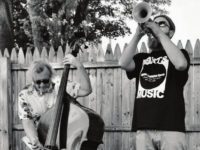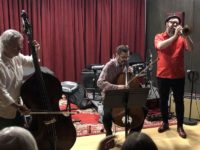New York-based Michael Bisio is widely regarded around town as one of most poetic, sensitive and inventive bassists on the scene, and that reputation manifests in his associations with Matthew Shipp, Ivo Perelman, Joe McPhee, Charles Gayle and other living heavies of the avant-garde. How Bisio got to be, well, Bisio is what his latest album attempts to reveal. Row For William O. is a tribute to Bisio’s old composition teacher Bill (William O.) Smith, who taught him about playing note patterns in a row of ascending major thirds as one way to convey substantive beauty in simple ways, giving rise to the title of this release. Uncomplicated beauty is, after all, a hallmark of Bisio’s bass.
Bisio is usually at his best interacting with other, like-minded musicians so he turned to cornetist Kirk Knuffke to play his foil and partner for this endeavor. Knuffke is a musician that Bisio rightly trusts to forge simpatico performances that are founded on soulful vigor, using virtuosity only as an enabling tool to achieve that. We’ve already heard the two make terrific art together in Bisio’s acclaimed Accortet last year but now the two practice an even purer form of spontaneous expression.
Knuffke has his own tone and diction. Like Bisio, he finds ample room to express freely within the melody itself while remaining acutely aware of what his partner is doing at all times. That’s what makes the title track, a sequential series of motifs shaped by improvs, work so well in spite of the challenges inherent in a song of such complexity: Bisio plays arco bass in the classical style, while Knuffke picks up cues and puts his own mark on them. A new, solemn section opens up in the middle section, creating the conditions for Bisio put down some spidery figures and engage some serious conversing with Knuffke before finally settling into a groove figure.
But most of the intrigue lies in how the two take traditional forms out to adventurous place. “Drago” begins as a scaled-down swing and ends that way too, but with a scamper for notes in-between. Bisio reworks his gorgeous melody from Accortet “I Want To Do To You What Spring Does To Cherry Trees,” where the two play to a rhythm section we can’t hear. But since it’s strongly inferred, Bisio is able to play loosely, picking up various thoughts harmonically attuned to the song alongside Knuffke’s sentimental cornet. A loping, paired figure opens “On See O.C.”, and they alternate be-bopping together and then around each other, and improvising as if of one mind. Knuffke takes a seat as Bisio deliberates with thoughtful conviction.
More of Bisio’s uniquely advanced and appealing musical personality can be found at nearly every turn with Knuffke intuitively facilitating and complementing. Row For William O. reveals Michael Bisio to be a great master because he is first and foremost such a good student.
- Claudio Scolari Project – ‘Bloom’ (2025) - June 12, 2025
- Denny Zeitlin – ‘With a Song In My Heart: Exploring The Music of Richard Rodgers’ (2025) - June 4, 2025
- Ches Smith Quartet – ‘Clone Row’ (2025) - May 30, 2025




